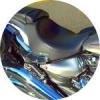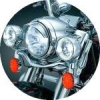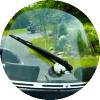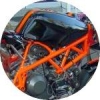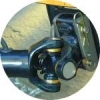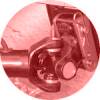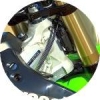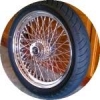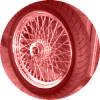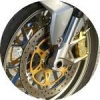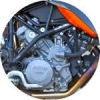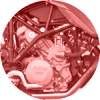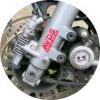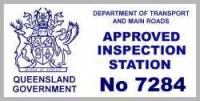Queensland Department of Transport and Main Roads introduced the safety certificate in November 1999 to replace the old roadworthy certificate or RWC, and it became
mandatory to obtain and display a current safety certificate on any registered motorcycle from the moment it's offered for sale.
The only times it's not required to display current safety certificate on a motorcycle for sale is when the motorcycle's either unregistered or is traded to or
between licensed motor dealers.
Queensland Department of Transport and Main Roads safety certificates can only be issued by Approved Inspection Stations (AIS), being service stations, garages or
workshops approved by Queensland Department of Transport and Main Roads to conduct inspections.
For private motorcycle sellers, Queensland Department of Transport and Main Roads safety certificates must be issued in the two months or 2000 kilometres prior to
sale, whichever comes first.
You are required to display a safety certificate in a conspicuous place and for motorcycles it's either on the forks or front guard.
Failure to display a Queensland Department of Transport and Main Roads safety certificate on the motorcycle from the time it's first offered for sale can carry an
on-the-spot fine penalty of $550.
Information on this website relating to motorcycle inspection is drawn from the Queensland Department of Transport and Main Roads Code of Practice for Approved
Inspection Stations (AIS) and Approved Persons; guidelines followed during safety certificate inspections and vehicle modification certification.
Following the code of practice guidelines below and rectifying faults you uncover should assure your motorcycle will pass on first inspection, avoiding any inconvenient
and possible costly re-inspection.
Vehicle inspection is subjective and the guidelines open to varying interpretation from inspector to inspector. Below is a list of reasons for possible rejection
pertaining to the Seating for the issuing of a Queensland Department of Transport and Main Roads safety certificate (formerly roadworthy certificate or RWC).
SECTION 1 - SEATS AND RESTRAINTS
Objective: To ensure that all seating and restraints fitted to a vehicle provide a comfortable and secure position for vehicle occupants.
In this section:-
Seating component includes cushions, backrests, head restraints, frames and slides and other controls (other than lumbar support controls).
Seat belt attachment includes buckles, tongues, adjustment devices and emergency locking retractors.
1.1 SEATING
Possible reasons for inspection rejection:
- Seating components are not fitted, not secure, are structurally damaged or have sharp or jagged edges or protrusions.
- A seating component used for adjustment of a seating position is not operational or does not hold a selected position allowed for in
the mechanism's design.
- Seating components are cracked, broken, distorted, missing or corroded to the point where the seat is weakened or failure is likely to
occur.
- Any seats are not securely mounted to the seat anchorage point.
- Any change to seating capacity is not certified by an Approved Person with the fitment of the prescribed modification plate with the
LK1 modification code.
- Where seats and seat belts have been removed from a vehicle (e.g. rear seats in a van), mounting holes in the floor panels have not
been sealed off to prevent the entry of fumes/gases to the vehicle's interior.
1.2 SEAT BELTS
Possible reasons for inspection rejection:
- Original manufacturer's seat belts are missing or replacement belts do not meet the vehicle manufacturer's specifications.
- Seat belt assemblies are not securely attached to the respective anchorage point or show signs of distortion, cracks, fractures or
other damage likely to cause failure.
- A seat belt stalk is missing or damaged.
- Seat belt webbing is not correctly and firmly secured at each end or is damaged, frayed, split, torn, altered or modified. (See Notes 1
and 2)
- When extended, the seat belt sash does not retract (the speed of retraction should not be a cause for rejection unless it affects the
overall operation of the seat belt assembly in any way).
- Seat belt attachments are not operational.
- Non-retractable seat belts do not have sufficient adjustment to allow effective use of the belts or do not maintain the adjusted
positions.
1.3 SEAT BELT ANCHORAGES
Possible reasons for inspection rejection:
- Anchorages provided by the vehicle manufacturer are not used wherever seat belts are fitted.
- Seat belt anchorages are not securely anchored to the structure of the vehicle or show signs of corrosion, distortion, cracks,
fractures or other damage likely to cause failure.
- Additional anchorages (not provided by the vehicle manufacturer) are not certified by an Approved Person with the fitment of a
prescribed modification plate marked with the LK1 modification code.
1.4 CHILD RESTRAINTS
Possible reasons for inspection rejection:
- Child restraint anchorages (where fitted) are not securely anchored to the structure of the vehicle and/or show signs of corrosion,
distortion, cracks, fractures or other damage likely to cause failure.
- Child restraint anchorage points are weakened or obstructed by the fitting of accessories (e.g. radio speakers or storage boxes
etc).
- Additional child restraint anchorages (those not provided by the vehicle's manufacturer) are not certified by an Approved Person with
the fitment of a modification plate marked with the LK6 modification code.
Notes about Section 1 (Seats and Restraints)::
[1] Information Sheet No. 2 in Vehicle Standards Instruction G21 - Information Sheets for Approved Examiners contains details of the ADR seat belt requirements.
[2] Discoloration alone of the seat belt webbing is not a cause for rejection.
Additional notes for Examiners:
- A modification plate issued by a suitably endorsed Approved Person to confirm the change in seating capacity is required.
- Seat belts that have been removed or added as part of an approved modification are permitted.
- If additional seats and seat belts or replacement seat belts are fitted, second-hand seat belts are not to be used.
- Additional information can also be found in the following Vehicle Standards Instructions:
- Vehicle Standards Instruction L 5 - Permanent and temporary removal of seats from light motor vehicles.
- Vehicle Standards Instruction G 10 - Seat Belt Assessment











